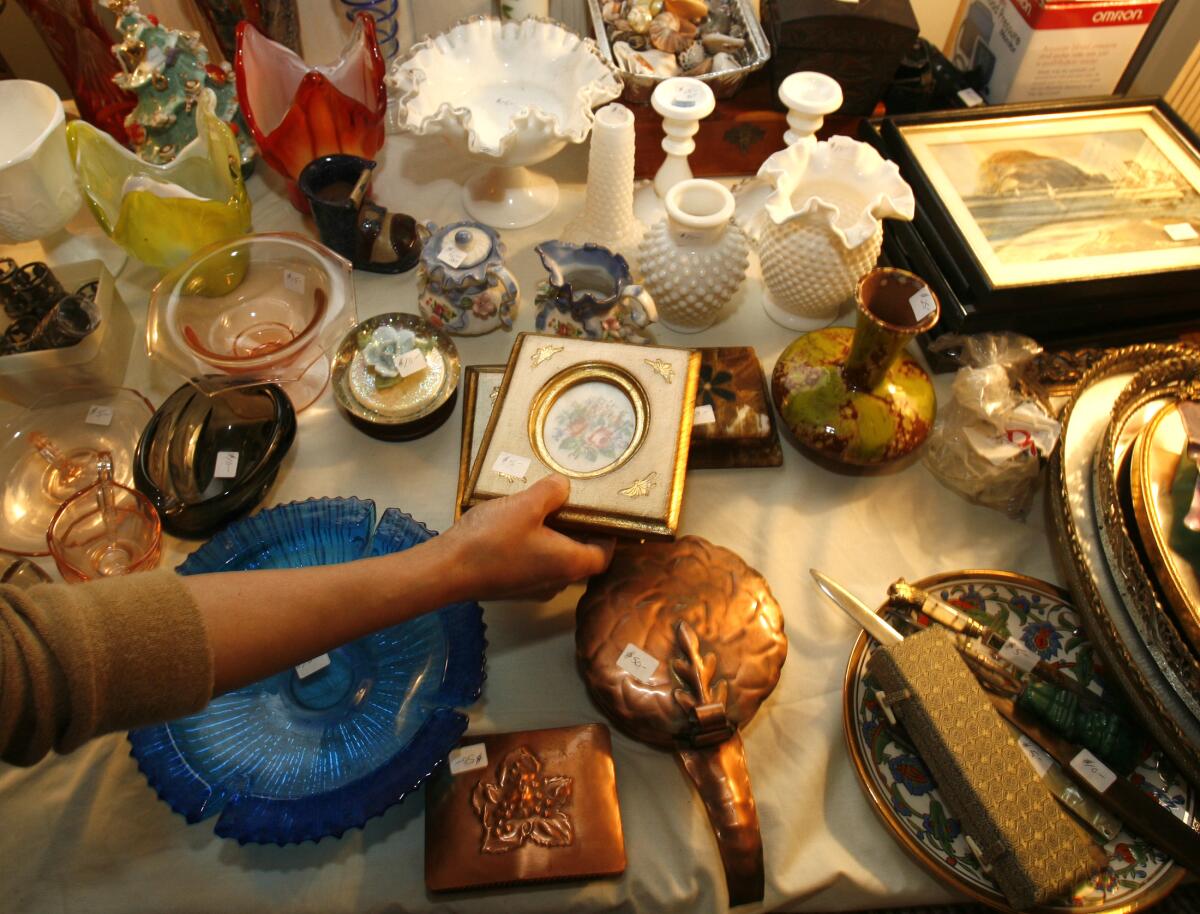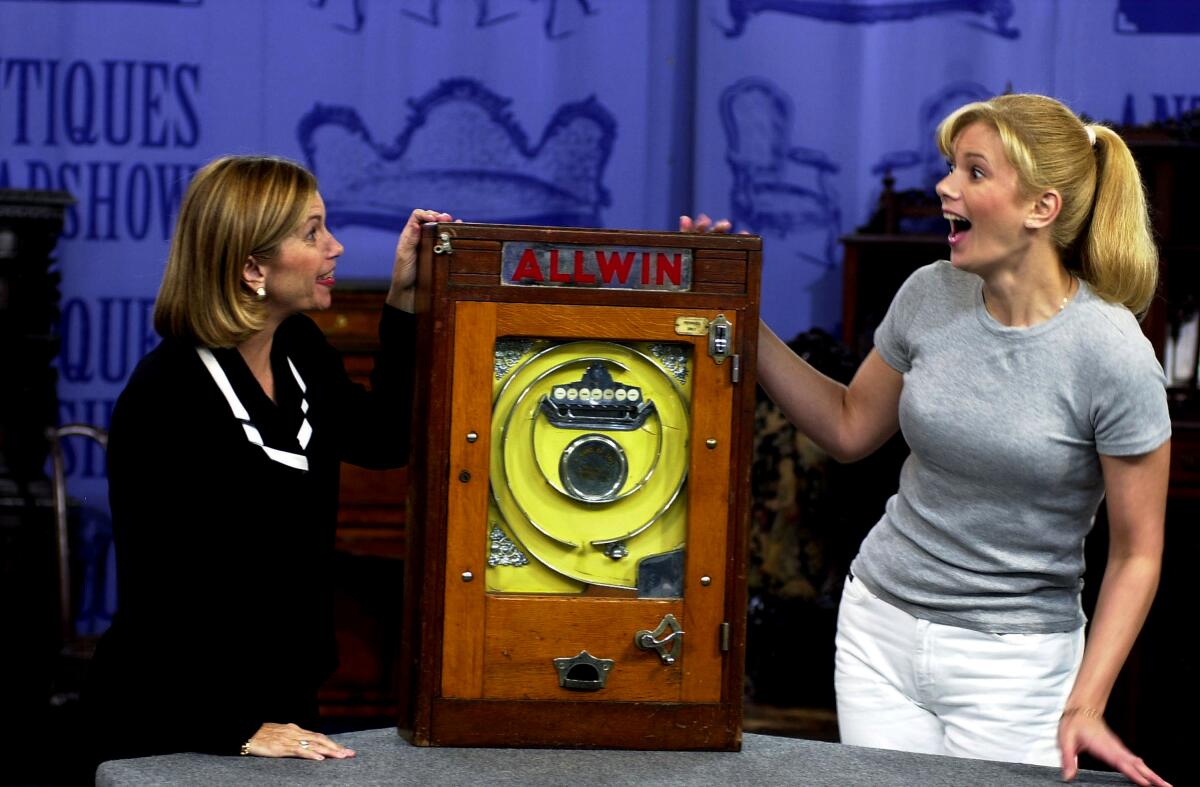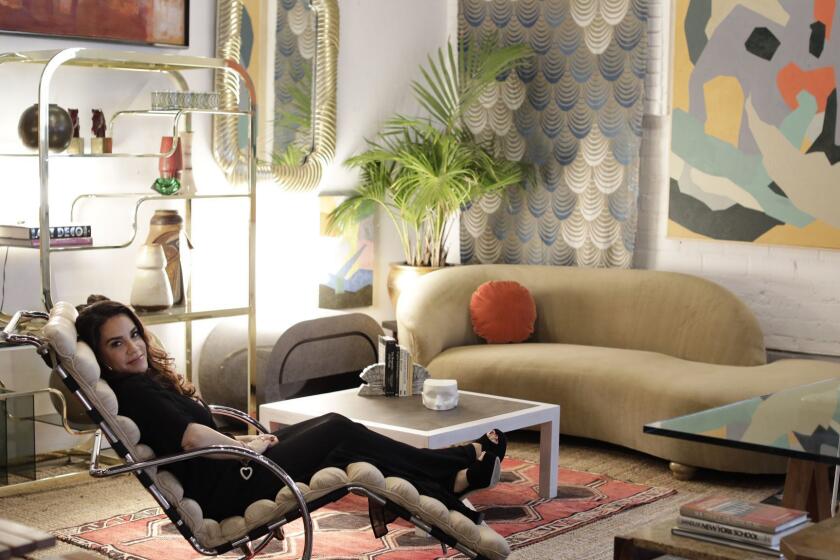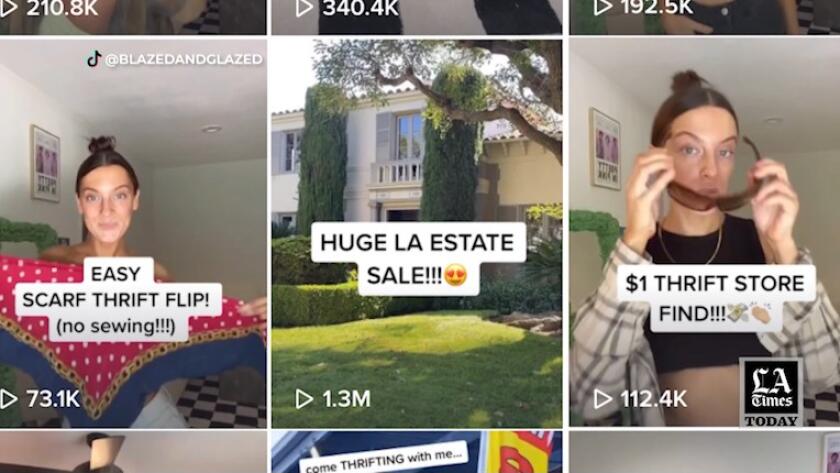In the pandemic, young folks discover antiques for Zoom and nostalgia

“Sup, queens,” Macy Eleni calls to her quarter-million TikTok followers in a recent video. “Welcome to another ultra-fabulous, packed-to-the-brim Los Angeles estate sale.”
Since the start of the pandemic, Eleni has racked up a rabid following as she shops her way through estate sales, thrift shops and antique stores, dropping tips for newbies to the pre-owned world she has haunted since she was a kid. The twist: Eleni is 28 and her followers skew even younger than her fellow millennials.
This runs counter to all that “the kids don’t want your stuff” downsizing advice doled out in recent years by AARP and others. PBS’ long-running “Antiques Roadshow” regularly updates vintage episodes showing sharply lower appraisal values, particularly for furniture.
But COVID has changed everything. Stuck at home and videoconferencing, young people with eco-conscious values have become a prized new market for antiques and art to liven up their spaces, moving up the shopping ladder from de rigueur vintage clothing, anecdotal evidence indicates.
“Gen Z is sick of fast fashion” in all areas of their consuming lives, Eleni said. “It’s not sustainable. It’s bad for people and it’s bad for the environment.”
Eleni realized she had tapped a rich vein when she was switching apartments during the first week of the coronavirus lockdown, and, with thrift stores closed down, she visited an estate sale to scope out things for her new place. The house was a 1980s mansion, and she decided to film the trip and turn it into a TikTok, where she is known as @blazedandglazed.
By the end of the day, her post had tens of thousands of views with a comments section full of teenagers who’d never heard of such an event, where people open their homes with an “everything must go” mentality. Usually, it’s because someone has died and the relatives want to sell their possessions quickly, or a homeowner is moving and can’t take everything with them.
Eleni never spends more than $100 per item, and her hauls have included antique jewelry, clothing, furniture and home décor. Standouts include a pair of custom trash cans: a leopard-print one and a ribbed-glass one she describes as “sexy ‘80s dad vibes.”
“Usually at the sales, they’re truly selling everything. You can take pillars off the walls,” she said.
Her rapid success has landed her partnerships with multiple companies that run estate sales. Often, she’ll go in a day early and film a video to promote the sale.
“TikTok blows everything up,” said Eleni, who graduated from Ohio University with a retail and fashion degree and hopes to eventually parlay the viral fame into a thrifting TV show. “Posting one video can change a thrift store’s life.”
Young shoppers visiting estate sales have been key to keeping her business afloat in the last year, said Sheryl Coughlan, who’s been selling antiques for 28 years, finding merchandise in alleyways and dumpsters back in the day. Now, she peddles the old goods through her Burbank store, Antiques on Magnolia, which promises “Beverly Hills merchandise for Burbank prices,” in addition to estate sales and EBay.
Since the start of the pandemic, Coughlan estimates a 35% increase in younger customers. To attract more, she has increased her social media presence and advertises her Facebook posts to a broader age range.
“If I relied just on the store, I don’t know if I would’ve made it,” she said after pandemic restrictions forced her to close for nine months. “Food, water and power is a necessity. Antiques aren’t.”
Tricia Beanum reclines on a vintage Mies van der Rohe MR lounge chair inside Pop Up Home and surveys her recent estate sale finds: vintage Persian rugs, midcentury pottery, a brass and glass Milo Baughman étagère.
Coughlan theorizes that antique buyer demographics have skewed younger during the pandemic because everyone is stuck inside all day and seeking a warmer, homier look — which she believes is the reason she’s been selling a slew of antique wood desks.
“You can buy a metal desk from Ikea, but it’ll break in six months and you’ll have to buy a new one,” she said. “Metal desks were fine for browsing social media, but now that we’re spending all day at our desk on Zoom, people want drawers and the warmth of wood.”
She added that one customer bought two Victrola record players as a display for their Zoom background — one for each corner.

It’s also an age of increased loneliness, Coughlan said, and young people are looking to connect with the relatives they’re unable to see in person. She said plenty of shoppers come into her store and note that a piece looks exactly like something their grandma owned, and they’ll buy it because of that alone.
Coughlan’s antiques usually cost anywhere from $500 into the thousands. She recently unloaded a fine china set appraised at $19,000 for $4,000. A few months back, she sold a 9-foot hand-carved French table for $2,200 that was valued at $12,000.
“We’re not holding out for big money here,” she said. “We’re trying to make a living. We’re trying to keep the doors open.”
Most of her money comes from estate sales, which she said can rack up $30,000 in three days while the store usually brings in $15,000 to $18,000 per month. She splits profits with the homeowners 50/50.
A recent sale in Hancock Park brought in 2,300 shoppers — a boon for profits but a logistical nightmare during a pandemic. Her team of four handles temperature checks and release forms while she sprays her way through hundreds of bottles of Lysol.
Stefani Colvin, a 21-year-old musician and estate sale frequenter, has another theory on the uptick in younger antique enthusiasts.
“Young people aspire to be different, especially Gen Z,” she said. “The idea of having something old no one has is appealing to us.”
During the pandemic, Colvin has been making money through Depop, a secondhand sales platform primarily used by Millennials and Gen Z. To date, she’s sold 1,541 items and racked up 30,000 followers for her unique offerings including Betty Boop tank tops, colorful sweaters and shirts with flaming skulls.
While many of her buys end up on Depop, she keeps some of the more interesting finds for herself, including a 1960s statue of a tiger cub and a handful of KISS collectibles she found at an estate sale of the band’s manager.
Among the masses at a recent Calabasas estate sale was 22-year-old Tori Ross. She arrived at 5 a.m., but that wasn’t quite early enough to beat out those who had slept in their cars overnight to ensure an early spot in line.
Since January, Ross has been hitting two to four estate sales every weekend and has filled her entire West Hollywood apartment with antiques including a Jonathan Adler glass table and a vintage wooden clock straight out of the 1970s.
The sales — which often pit younger shoppers looking for unique finds against career collectors trying to buy up all the best merchandise and resell it for a profit — can often turn chaotic. Ross said there have been fights at the last two she’s attended.
“Someone brought their own clipboard with a paper and pen and put their names at the top of a list to try to get early access, but the person running the sale caught them because there wasn’t a list to begin with,” she said.
Denied entry, the people with the fake list scheme returned hours later disguised in yellow raincoats, big sunglasses and foreign accents. That didn’t work either.
At the same sale, Ross said, someone before her in line bought up most of the high-end clothing and spent a total of $20,000. Meanwhile, Ross landed a pair of 1992 Louboutins inspired by Andy Warhol, a jacket, a painting and a handful of porn films on VHS.
Like Eleni, she’s found viral fame through TikTok, and a video she made from footage of the Calabasas sale has nearly a million views on the app.
The technology behind Thursday’s $69-million digital painting sale may be a bubble, or it may be the wave of the future in art and media. Maybe both.
While Gen Z descends on estate sales and antique stores, a slightly older, slightly wealthier generation is making its way into the high-end arts scene. Stuck inside with disposable income and nowhere to spend it, wealthy 30-somethings have been driving a market that’s traditionally been confined to ultra-rich elites.
Art dealers Daniel and Dori Rootenberg are the directors of Jacaranda, a New York City-based gallery founded in 2007 that sells high-end historic art to collectors and museums. Thanks to the emerging market, their business hasn’t skipped a beat over the last year.
“The demographics of our area of art has always skewed older, but younger people are getting into it,” Daniel said. “We were thinking it was going to be a terrible year, but it’s been the exact opposite.”
Daniel, a native of South Africa, and Dori, a native New Yorker with a degree in art history, specialize in art from Africa, Oceania and North America. They had nearly hit their 2021 sales forecast already by February. They said they’ve sold art to LACMA and every other major museum in the country, and their pieces — African Dan masks, Zulu ear plugs, 1,000-year-old tattoo needles, etc. — range from $500 to $500,000.
“We’ve sold fish hooks for $10,000,” Daniel said.
Traditionally, their buyer base has been limited to museums and collectors on the coasts, but these days, they’re finding customers who are simply looking for something beautiful for their home.
“That’s the beauty of the internet,” Dori said. “People are comfortable spending $100,000 on a piece literally based on a picture.”
The couple run a physical gallery from their pre-war apartment in New York, with art shelves lining the foyer and prized pieces filling the living spaces. They still do in-person showings on occasion, but these days, most of the action happens online — which is perfect during a year of lockdowns.
“People can’t travel during the pandemic, so this appeals to their sense of wanderlust,” Dori said. “They can get something that comes from an exotic place with an interesting story without leaving their home and can talk about it when friends come over.”
Daniel hunts for new pieces while Dori reaches out to potential buyers on Instagram. They publish online art catalogs and also create videos that display the pieces from every angle to make sure buyers can get as close as possible to experiencing the art before they buy it.
To keep up with the new generation of buyers, the Rootenbergs joke that they will need to figure out TikTok for their next big campaign. In a few years, they might not be joking.
Watch L.A. Times Today at 7 p.m. on Spectrum News 1 on Channel 1 or live stream on the Spectrum News App. Palos Verdes Peninsula and Orange County viewers can watch on Cox Systems on channel 99.













